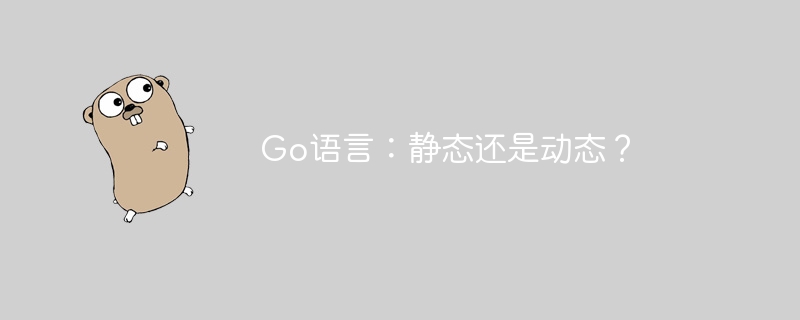Go language: static or dynamic?
Go is a statically typed language, but it supports some dynamic features through the use of interface{} types, allowing dynamic checking of variable types at runtime. This provides flexibility, but needs to be used with caution to avoid runtime errors.

Go language: static or dynamic?
The Go programming language is known for its static type system, but it also supports some elements of dynamic nature. Understanding Go's balance between static and dynamic typing is critical.
Static typing
Static typing means that the compiler checks the types of variables and expressions at compile time. This helps ensure that no type errors or unexpected conversions of data types occur at run time.
In Go, variables must be explicitly typed when declared, for example:
var age int // 声明一个 int 类型变量
The compiler will verify all types in the code at compile time and report any inconsistencies.
Dynamic typing
Dynamic typing refers to checking the types of variables and expressions at run time. This approach provides greater flexibility, but also increases the risk of runtime errors.
There is no native support for dynamic typing in Go, but it can be emulated by using the interface{} interface type. interface{} Types can hold values of any type, allowing dynamic checking of types at runtime.
var value interface{} // 声明一个 interface{} 类型变量
value = 10 // 将一个 int 值分配给 value
switch value.(type) {
case int:
// value 是 int 类型
case string:
// value 是 string 类型
default:
// value 是其他类型
}Practical case
Suppose we have a function that needs to handle a parameter of any type. We can use interface{} to dynamically check the type of a parameter:
func processValue(value interface{}) {
switch value.(type) {
case int:
// 执行 int 类型的处理
case string:
// 执行 string 类型的处理
default:
// 处理其他类型的参数
}
}Conclusion
The Go language uses interface{} to simulate dynamic typing, providing a balance between static and dynamic typing. Understanding this balance is critical to writing safe and efficient Go applications.
The above is the detailed content of Go language: static or dynamic?. For more information, please follow other related articles on the PHP Chinese website!

Hot AI Tools

Undresser.AI Undress
AI-powered app for creating realistic nude photos

AI Clothes Remover
Online AI tool for removing clothes from photos.

Undress AI Tool
Undress images for free

Clothoff.io
AI clothes remover

AI Hentai Generator
Generate AI Hentai for free.

Hot Article

Hot Tools

Notepad++7.3.1
Easy-to-use and free code editor

SublimeText3 Chinese version
Chinese version, very easy to use

Zend Studio 13.0.1
Powerful PHP integrated development environment

Dreamweaver CS6
Visual web development tools

SublimeText3 Mac version
God-level code editing software (SublimeText3)

Hot Topics
 1382
1382
 52
52
 What libraries are used for floating point number operations in Go?
Apr 02, 2025 pm 02:06 PM
What libraries are used for floating point number operations in Go?
Apr 02, 2025 pm 02:06 PM
The library used for floating-point number operation in Go language introduces how to ensure the accuracy is...
 What is the problem with Queue thread in Go's crawler Colly?
Apr 02, 2025 pm 02:09 PM
What is the problem with Queue thread in Go's crawler Colly?
Apr 02, 2025 pm 02:09 PM
Queue threading problem in Go crawler Colly explores the problem of using the Colly crawler library in Go language, developers often encounter problems with threads and request queues. �...
 In Go, why does printing strings with Println and string() functions have different effects?
Apr 02, 2025 pm 02:03 PM
In Go, why does printing strings with Println and string() functions have different effects?
Apr 02, 2025 pm 02:03 PM
The difference between string printing in Go language: The difference in the effect of using Println and string() functions is in Go...
 What should I do if the custom structure labels in GoLand are not displayed?
Apr 02, 2025 pm 05:09 PM
What should I do if the custom structure labels in GoLand are not displayed?
Apr 02, 2025 pm 05:09 PM
What should I do if the custom structure labels in GoLand are not displayed? When using GoLand for Go language development, many developers will encounter custom structure tags...
 How to solve the user_id type conversion problem when using Redis Stream to implement message queues in Go language?
Apr 02, 2025 pm 04:54 PM
How to solve the user_id type conversion problem when using Redis Stream to implement message queues in Go language?
Apr 02, 2025 pm 04:54 PM
The problem of using RedisStream to implement message queues in Go language is using Go language and Redis...
 Which libraries in Go are developed by large companies or provided by well-known open source projects?
Apr 02, 2025 pm 04:12 PM
Which libraries in Go are developed by large companies or provided by well-known open source projects?
Apr 02, 2025 pm 04:12 PM
Which libraries in Go are developed by large companies or well-known open source projects? When programming in Go, developers often encounter some common needs, ...
 What is the difference between `var` and `type` keyword definition structure in Go language?
Apr 02, 2025 pm 12:57 PM
What is the difference between `var` and `type` keyword definition structure in Go language?
Apr 02, 2025 pm 12:57 PM
Two ways to define structures in Go language: the difference between var and type keywords. When defining structures, Go language often sees two different ways of writing: First...
 When using sql.Open, why does not report an error when DSN passes empty?
Apr 02, 2025 pm 12:54 PM
When using sql.Open, why does not report an error when DSN passes empty?
Apr 02, 2025 pm 12:54 PM
When using sql.Open, why doesn’t the DSN report an error? In Go language, sql.Open...




